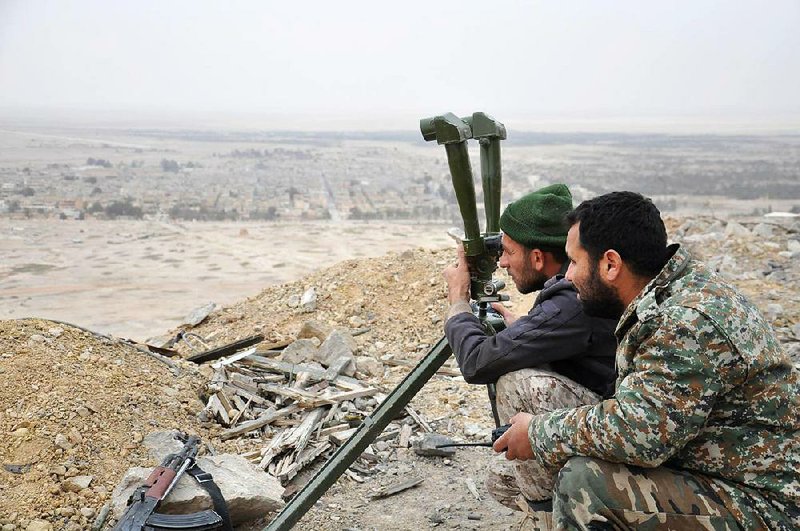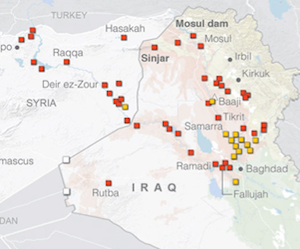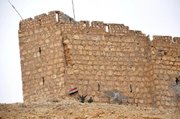DAMASCUS, Syria -- Syrian government forces backed by Russian airstrikes drove Islamic State fighters from Palmyra, ending the group's reign of terror over a city whose famed 2,000-year-old ruins once drew tens of thousands of visitors each year.
Islamic State extremists have destroyed many of the monuments in the city, a UNESCO World Heritage site known to Syrians as the "bride of the desert." Initial footage on Syrian TV showed widespread rubble and shattered statues, but Palmyra's grand colonnades appeared to be in relatively good condition.
The government forces were supported by Lebanese militias and Russian air power. The Islamic State now faces pressure on several fronts as Kurdish ground forces advance on its territory in Syria's north and government forces have a new path to its de facto capital, Raqqa, and the contested eastern city of Deir el-Zour.
Russian President Vladimir Putin phoned Syrian President Bashar Assad to congratulate him on retaking Palmyra, a Kremlin spokesman said. Assad responded by saying that "successes like the liberation of Palmyra [would be] impossible without Russia's help."
International airstrikes have pounded Islamic State territory, killing two top leaders in recent weeks, according to the Pentagon. Those strikes have also inflicted dozens of civilian casualties.
In Iraq, government forces backed by the U.S. and Iran are preparing a ground offensive to retake the country's second-largest city, Mosul.
The fall of Palmyra comes a month after a partial cease-fire in Syria's civil war came into force. The truce was sponsored by the United States and Russia in part to allow the government and international community to focus on al-Qaida styled militants, among them the Islamic State extremist group, also known as ISIS.
In comments reported on state TV, Assad described the Palmyra operation as a "significant achievement" offering "new evidence of the effectiveness of the strategy espoused by the Syrian army and its allies in the war against terrorism."
Assad also seized the breakthrough to criticize the United States, which has repeatedly called for his departure. He contrasted his force's recapture of Palmyra with what he calls a "lack of seriousness of the alliance [against Islamic State extremists] led by the United States."
The U.S.-led alliance has achieved only "paltry results," Assad told a visiting French delegation, according to state TV.
The Islamic State drove government forces from Palmyra in a matter of days last May and later demolished some of its best-known monuments, including two large temples dating back more than 1,800 years and a Roman triumphal archway.
State TV showed the rubble left over from the destruction of the Temple of Bel as well as the damaged archway, the supports of which were still standing. It said a statue of Zenobia, the third century queen who ruled an independent state from Palmyra and figures strongly in Syrian lore, was missing.
Artifacts inside the city's museum also appeared heavily damaged on state TV. A sculpture of the Greek goddess Athena was decapitated, and the museum's basement appeared to have been dynamited, the hall littered with broken statues.
Still, state media reported that a lion statue dating back to the second century, previously thought to have been destroyed by Islamic State militants, was found in a damaged but recoverable condition.
Extremists beheaded the archaeological site's director, Riad al-Asaad, 81, in August after he reportedly refused to divulge where authorities had hidden treasures before the group swept in. Militants viewed the ruins as monuments to idolatry.
The Islamic State also demolished Palmyra's Tadmur prison, where thousands of government opponents were reportedly tortured.
Syrian state TV hailed the government's advance, and a local reporter spoke live from inside Palmyra, showing troops in the center of the town, where some buildings had been reduced to rubble.
Syrian Culture Minister Issam Khalil described the recapture as a "victory for humanity and right over all projects of darkness."
Maamoun Abdulkarim, director of the museums and antiquities department in Damascus, said Palmyra's Great Colonnade had suffered only minor damage.
"We will rebuild what you have destroyed," he said, addressing the Islamic State.
Abdulkarim, who has not been able to visit Palmyra for the past two years because of the fighting there, said Sunday that he hoped to visit the city within a day or two.
U.N. Secretary-General Ban Ki-moon also praised the advance, on Sunday calling the retaking of the ancient city "fortunate" and saying the Syrian government could now protect and restore the sites, wire services reported.
The Syrian opposition, which blames the government for the country's devastating civil war and the rise of the Islamic State, rejected that narrative.
"The government wants through this operation to win the favor of Western nations by fighting against terrorism, while obscuring its responsibility as providing the reasons for the spread of terror," said Khaled Nasser, a member of the opposition coalition that has been negotiating with the government in Geneva.
The Britain-based Syrian Observatory for Human Rights, which monitors the conflict through local activists, said that the Islamic State had lost the city but that fighting continued in a few districts of the city, as well as at a military prison. Observatory chief Rami Abdurrahman said three weeks of fighting killed more than 400 Islamic State fighters, as well as 180 troops and allied militiamen.
Residents told The Associated Press that the Islamic State evacuated all of Palmyra's civilians to other territories under its control before government forces entered the city.
"It's joyful for people to return home. Still we are sad to see damage in this historical city," said Sohban Eleiwi, a businessman from Palmyra now residing in Homs.
Other residents said they would not return to live under government rule.
"We don't hate the regime any less than we hate Daesh," said Osama Khatib, a Palmyra native who fled to Turkey three years ago after serving a jail sentence for taking part in demonstrations.
"Daesh and the regime behave the same way," he said, using an Arabic acronym to refer to the Islamic State.
Government forces had been trying to retake the town for nearly three weeks. Gen. Ali Mayhoub announced on Syrian TV Sunday afternoon that its recapture "directs a fatal blow to Daesh, undermines the morale of its mercenaries and ushers in the start of its defeat and retreat."
Government forces have advanced on a number of fronts in recent months, aided by a Russian air campaign. Moscow announced earlier this month that it would begin drawing down its forces, but said it will continue to target the Islamic State and other extremist groups.
Syria's conflict began a little more than five years ago with mostly peaceful protests against the Assad family's four-decade rule. A fierce government crackdown and the rise of an insurgency plunged the country into a full-blown civil war that has killed more than 250,000 people.
The attack on Palmyra comes amid a nationwide cease-fire that has substantially reduced violence, despite numerous violations claimed by government and anti-government fighters.
The partial truce does not include the Islamic State and has received strong backing from Russia and the United States, even though the two powers support opposing sides in the conflict.
The recapture of Palmyra is the latest sign that the Islamic State has been badly weakened in its strongholds in Iraq and Syria by both pro-Assad fighters and U.S.-backed Kurdish and Arab forces.
Late last year, Iraqi forces drove Islamic State militants out of the city of Ramadi. In February, Kurdish fighters defeated the group at al-Shaddadi, a town in eastern Syria.
U.S. military officials estimate that the group has lost more than 40 percent of the territory it held in Iraq and more than 20 percent in Syria.
Information for this article was contributed by Albert Aji, Philip Issa and Bassem Mroue of The Associated Press; by Hugh Naylor of The Washington Post; Hwaida Saad, Kareem Fahim, Maher Samaan and Anne Barnard of The New York Times; and by Pol O Gradaigh of Tribune News Service.
A Section on 03/28/2016



